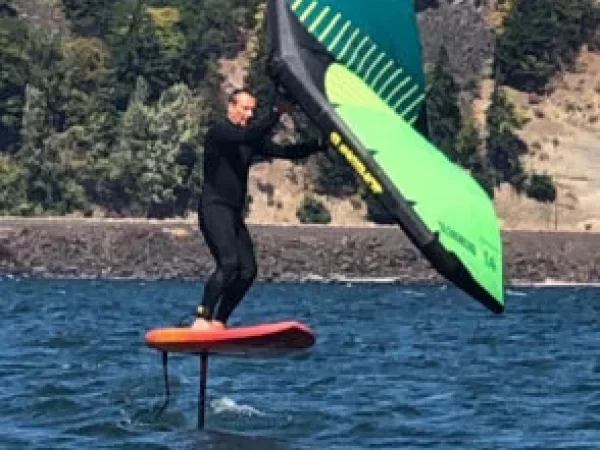Life is one big evolutionary process. Obviously, you are the best judge of that evolution, but if you are curious, here is how to know when you are truly ready to transition from wing surfing on your SUP and daggerboard to winging on a foil.
Ideally, you want to be able to wing comfortably back and forth on your SUP and stay upwind. The more wing control you have under your belt the better! Being able to run and jump with the wing on the beach, riding with the wing on a skateboard, skis, or ice skates will help build your wing control skills. Make sure you have proficient wing skills before attempting the foil.
TIPS & TRICKS FOR PROGRESSION
1. Start BIG.
The bigger your foil board, and the bigger the front foil wing you use. This tip will increase overall stability and makes it easier to learn both behind a boat and with a wing. Don’t try to go too small in either board size or front foil wing size right away. Choosing larger equipment will also allow you to get foiling in less wind.
2. Flat water really helps!
Whether behind a boat or with a wing, having flat water will make everything easier. Choose a location without choppy water or waves.
3. Positive Positioning.
With a wing, you will want to start well upwind of your take-out point. Giving yourself plenty of space to drift downwind allows you to concentrate on building speed to get the board up onto the foil instead of concentrating on staying upwind.
4. Size Up.
At first, your efficiency will be very low. As a beginner you will want to use a 1.0M larger wings than more proficient riders.
5. Work on your stance.
Once on the board, adopt an incredibly wide stance with your feet on the centerline of the board (surfer stance) over the footstrap insert holes. This will keep the board in the water longer and stop the board from doing “a wheelie”. A wide stance also gives you better flight height control. A narrow stance is one of the biggest mistakes of beginners. Once up and foiling comfortably, you can shift your feet around and narrow your stance. A wide stance is incredibly important for getting up onto foil in control and avoiding the “wheelie”
6. Row your wing.
For more power and to build the board speed required to get the board to lift off of the water, extend your front arm towards the nose of the board so the wing is pulling your forward towards the nose of the board. Pump the wing by pulling it from nose to tail, driving the board forward with your feet. It is a bit like rowing a boat as you pull the wing from its extended position towards the nose and then back towards the tail in a semi-circular motion.
7. Get lifted!
As the board starts to lift, try and keep the board as flat as possible. Foils are very sensitive to weight shifts, both front foot to back foot and heel to toe. Keep the board flat!
8. Weight distribution.
Once you are comfortably up and riding, begin to transition weight to your heels to get the board to turn upwind. This will slow things down and allow you to gain upwind ground.






